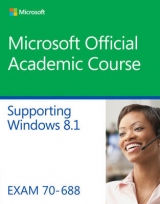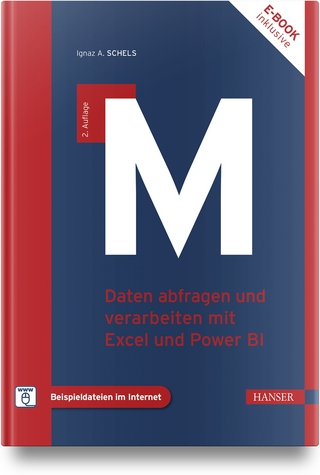
Exam 70–688 Managing and Maintaining Windows 8
John Wiley & Sons Inc (Verlag)
978-1-118-59193-2 (ISBN)
- Titel erscheint in neuer Auflage
- Artikel merken
MOAC gets instructors ready to teach and students ready for work by delivering essential resources in 5 key areas: Instructor readiness, student software, student assessment, instruction resources, and learning validation. With the Microsoft Official Academic course program, you are getting instructional support from Microsoft; materials that are accurate and make course delivery easy. Request your sample materials today.
The Microsoft Official Academic Course series is a complete program for instructors and institutions to prepare and deliver great courses on Microsoft software technologies. With MOAC, we recognize that, because of the rapid pace of change in the technology and curriculum developed by Microsoft, there is an ongoing set of needs beyond classroom instruction tools for an instructor to be ready to teach the course. MOAC endeavors to provide solutions for all these needs in a systematic manner in order to ensure a successful and rewarding course experience for both instructor and student—technical and curriculum training for instructor readiness with new software releases, the software itself for student use at home for building hands-on skills, assessment and validation of skill development, and a great set of tools for delivering instruction in the classroom and lab. All are important to the smooth delivery of an interesting course on Microsoft software, and all are provided with the Microsoft Official Academic Course program.
PART I THE MICROBES 1 The Microbial World 2 1.1 The Microbes 4 Toolbox 1.1 POLYMERASE CHAIN REACTION AMPLIFICATION OF rRNA GENES 12 Mini-Paper: A Focus on the Research THE THREE DOMAINS OF LIFE 14 1.2 Microbial Genetics 16 Perspective 1.1 CREATING LIFE IN THE LABORATORY: THE MILLER--UREY EXPERIMENT 18 Perspective 1.2 RIBOZYMES: EVIDENCE FOR AN RNA-BASED WORLD 19 1.3 Microbial Metabolism and Ecology 24 1.4 Microbes and Disease 27 2 Bacteria 36 2.1 Morphology of Bacterial Cells 38 2.2 The Cytoplasm 41 2.3 The Bacterial Cytoskeleton 44 2.4 The Cell Envelope 45 Perspective 2.1 MARVELOUS MAGNETOSOMES! 46 Toolbox 2.1 THE GRAM STAIN 55 Perspective 2.2 THE PROTECTIVE SHELLS OF ENDOSPORES 57 Mini-Paper: A Focus on the Research NEW MICROSCOPY METHODS REVEAL A PERIPLASM IN GRAM-POSITIVE BACTERIAL CELLS 60 2.5 The Bacterial Cell Surface 62 2.6 Bacterial Taxonomy 68 3 Eukaryal Microbes 72 3.1 The Morphology of Typical Eukaryal Cells 74 Mini-Paper: A Focus on the Research LIPID RAFTS: ORGANIZED CLUSTERING OF LIPIDS WITHIN A MEMBRANE 80 Toolbox 3.1 USING MICROSCOPY TO EXAMINE CELL STRUCTURE 82 Perspective 3.1 HIJACKING THE CYTOSKELETON 86 3.2 Diversity of Eukaryal Microbes 87 3.3 Replication of Eukaryal Microbes 92 3.4 The Origin of Eukaryal Cells 95 Perspective 3.2 EXPLOITING A SHARED EVOLUTIONARY HISTORY WITH PLANTS IN THE TREATMENT OF MALARIA 99 3.5 Interactions Between Eukaryal Microbes and Animals, Plants, and the Environment 100 4 Archaea 106 4.1 Distinctive Properites of Archaea 108 4.2 Archaeal Cell Structure 110 Toolbox 4.1 VACCINE DELIVERY STRATEGIES 115 4.3 Diversity of Archaea 119 Perspective 4.1 EXTREMOPHILES AND BIOTECHNOLOGY 121 Mini-Paper: A Focus on the Research THE ROLE OF ARCHAEONS IN OUR DIGESTIVE SYSTEM 126 5 Viruses 130 5.1 A Basic Overview of Viruses 132 5.2 Origins of Viruses 140 5.3 Cultivation, Purification, and Quantification of Viruses 142 Toolbox 5.1 CELL CULTURE TECHNIQUES 143 Perspective 5.1 MEASUREMENT OF HIV VIRAL LOAD 147 5.4 Diversity of Viruses 149 Toolbox 5.2 REVERSE TRANSCRIPTASE POLYMERASE CHAIN REACTION (RT-PCR) 154 5.5 Virus-Like Particles 155 5.6 Virology Today 157 Mini-Paper: A Focus on the Research NEW FINDINGS IN THE PACKAGING OF DNA BY THE MODEL BACTERIOPHAGE T4 158 6 Cultivating Microorganisms 164 6.1 Nutritional Requirements of Microorganisms 166 6.2 Factors Affecting Microbial Growth 168 Toolbox 6.1 PHENOTYPE MICROARRAYS FOR EXAMINING MICROBIAL GROWTH 169 6.3 Growing Microorganisms in the Laboratory 173 Perspective 6.1 THE DISCOVERY OF HELICOBACTER PYLORI 178 Toolbox 6.2 FISHING FOR UNCULTIVATED MICROBES 180 Mini-Paper: A Focus on the Research BRINGING TO LIFE THE PREVIOUSLY UNCULTURABLE USING THE SOIL SUBSTRATE MEMBRANE SYSTEM (SSMS) 182 6.4 Measuring Microbial Population Growth 184 Perspective 6.2 MYCOBACTERIUM LEPRAE, AN EXTRAORDINARILY SLOW-GROWING PATHOGEN 190 Perspective 6.3 THE HUMAN INTESTINE--A CONTINUOUS CULTURE 192 6.5 Eliminating Microbes and Preventing Their Growth 192 PART II MICROBIAL GENETICS 7 DNA Replication and Gene Expression 202 7.1 The Role of DNA 204 7.2 DNA Replication 210 7.3 Transcription 216 Toolbox 7.1 USING A GEL SHIFT ASSAY TO IDENTIFY DNA-BINDING PROTEINS 219 7.4 Translation 233 7.5 The Effects of Mutations 229 Mini-Paper: A Focus on the Research TELOMERES WITH PROMOTER ACTIVITY 232 Perspective 7.1 USING MUTATIONS TO CONTROL VIRAL INFECTIONS 234 8 Viral Replication Strategies 238 8.1 Recognition of Host Cells 240 Toolbox 8.1 THE WESTERN BLOT 242 8.2 Viral Entry and Uncoating 244 8.3 Viral Replication 248 8.4 Viral Assembly and Egress 256 8.5 Antiviral Drugs 258 Perspective 8.1 DNA MICROARRAYS AND THE SARS VIRUS 258 Mini-Paper: A Focus on the Research THE DISCOVERY OF REVERSE TRANSCRIPTASE 262 9 Bacterial Genetic Analysis 266 9.1 Bacteria as Subjects of Genetic Research 268 9.2 Mutations, Mutants, and Strains 271 Toolbox 9.1 ISOLATING NUTRITIONAL MUTANTS 274 9.3 Restriction Enzymes, Vectors, and Cloning 278 9.4 Recombination and DNA Transfer 285 Perspective 9.1 PLASMIDS THAT PRODUCE PATHOGENS 290 Mini-Paper: A Focus on the Research THE DISCOVERY OF TRANSDUCTION 299 10 Microbial Genomics 302 10.1 Genome Sequencing 304 Perspective 10.1 RATE OF DNA SEQUENCING 307 Toolbox 10.1 GENOME DATABASES 310 10.2 Genomic Analysis of Gene Expression 312 10.3 Comparative Genomics 318 Perspective 10.2 THE MINIMAL GENOME 319 Mini-Paper: A Focus on the Research GENOME SEQUENCE OF A KILLER BUG 320 10.4 Metagenomics 323 11 Regulation of Gene Expression 328 11.1 Differential Gene Expression 330 11.2 The Operon 332 11.3 Global Gene Regulation 337 Mini-Paper: A Focus on the Research TUNING PROMOTERS FOR USE IN SYNTHETIC BIOLOGY 338 Perspective 11.1 THE USE OF LACTOSE ANALOGS IN GENE EXPRESSION STUDIES 342 11.4 Post-initiation Control of Gene Expression 346 Toolbox 11.1 USING RNA MOLECULES TO DECREASE GENE EXPRESSION 347 11.5 Quorum Sensing 350 11.6 Two-Component Regulatory Systems 352 11.7 Chemotaxis 355 12 Microbial Biotechnology 362 12.1 Microbes for Biotechnology 365 Perspective 12.1 BIOPROSPECTING: WHO OWNS THE MICROBES? 366 12.2 Molecular Genetic Modification 368 Toolbox 12.1 SITE-DIRECTED MUTAGENESIS 370 Toolbox 12.2 FUSION PROTEIN PURIFICATION 375 Mini-Paper: A Focus on the Research MAKING A SYNTHETIC GENOME 378 Perspective 12.2 THE INTERNATIONAL GENETICALLY ENGINEERED MACHINE (IGEM) COMPETITION, STANDARD BIOLOGICAL PARTS, AND SYNTHETIC BIOLOGY 380 12.3 Red Biotechnology 381 12.4 White Biotechnology 382 Perspective 12.3 BIOFUELS: BIODIESEL AND ALGAE 386 12.5 Green Biotechnology 391 Toolbox 12.3 PLANT TRANSFORMATION USING BACTERIA 394 PART III MICROBIAL PHYSIOLOGY AND ECOLOGY 13 Metabolism 400 13.1 Energy, Enzymes, and ATP 402 Perspective 13.1 WHO NEEDS VITAMINS? 405 13.2 Central Processes in ATP Synthesis 406 13.3 Carbon Utilization in Microorganisms 412 13.4 Respiration and the Electron Transport System 422 Perspective 13.2 ELECTRICIGENIC BACTERIA AND MICROBIAL FUEL CELLS 426 13.5 Metabolism of Non-glucose Carbon Sources 429 Toolbox 13.1 METABOLISM AND RAPID BACTERIAL IDENTIFICATION SYSTEMS 432 13.6 Phototrophy and Photosynthesis 433 13.7 Nitrogen and Sulfur Metabolism 443 13.8 Biosynthesis of Cellular Components 447 Mini-Paper: A Focus on the Research GENOME SEQUENCE OF A DEEP SEA SYMBIONT 450 14 Biogeochemical Cycles 456 14.1 Nutrient Cycling 459 Toolbox 14.1 USING MICROARRAYS TO EXAMINE MICROBIAL COMMUNITIES: THE GeoCHIP 461 14.2 Cycling Driven by Carbon Metabolism 463 Perspective 14.1 CO2 AS A GREENHOUSE GAS AND ITS INFLUENCE ON CLIMATE CHANGE 464 14.3 Cycling Driven by Nitrogen Metabolism 472 Mini-Paper: A Focus on the Research THE FIRST ISOLATION AND CULTIVATION OF A MARINE ARCHAEON 476 14.4 The Interconnectedness of Cycles 478 Perspective 14.2 THE MICROBIOLOGY OF ENVIRONMENTALLY TOXIC ACID MINE DRAINAGE 479 15 Microbial Ecosystems 484 15.1 Microbes in the Environment 486 15.2 Microbial Community Structure 490 Toolbox 15.1 FLOW CYTOMETRY 494 Mini-Paper: A Focus on the Research A METHOD FOR THE IDENTIFICATION OF CATABOLIC GENES FROM METAGENOMIC LIBRARIES BASED ON THEIR GENE EXPRESSION CHARACTERISTICS 496 Perspective 15.1 NAMING THE UNCULTURABLE AND UNCHARACTERIZED 498 15.3 Aquatic Ecosystems 498 Perspective 15.2 DEAD ZONES 499 15.4 Terrestrial Ecosystems 506 15.5 Deep Subsurface and Geothermal Ecosystems 512 16 The Microbiology of Food and Water 522 16.1 Food Spoilage 524 16.2 Food Preservation 528 16.3 Food Fermentation 534 PART IV MICROBES AND DISEASE 18 Introduction to Infectious Diseases 600 18.1 Pathogenic Microbes 603 Toolbox 18.1 MEASURING THE VIRULENCE OF PATHOGENS 606 18.2 Microbial Virulence Strategies 608 Perspective 18.1 HOST DEFENSES IN BACTERIA 612 18.3 The Transmission of Infectious Diseases 613 18.4 Proving Cause and Effect in Microbial Infections 621 Perspective 18.2 THE ARMADILLO--AN IDEAL ANIMAL MODEL? 624 18.5 The Evolution of Pathogens 625 Mini-Paper: A Focus on the Research EPIDEMIOLOGY OF AN INFECTIOUS DISEASE 626 19 Innate Host Defenses Against Microbial Invasion 636 19.1 Immunity 638 19.2 Barriers to Infection 639 Perspective 19.1 MESSY MUCUS 642 19.3 The Inflammatory Response 643 19.4 The Molecules of the Innate System 644 Toolbox 19.1 THE COMPLEMENT FIXATION TEST 650 19.5 The Cells of Innate Immunity 653 Perspective 19.2 NATURAL BORN KILLERS 659 19.6 Invertebrate Defenses 663 Mini-Paper: A Focus on the Research MAMMALIAN CELLS CAN RECOGNIZE BACTERIAL DNA 664 Toolbox 19.2 THE LIMULUS AMOEBOCYTE ASSAY FOR LPS 667 16.4 Foodborne and Waterborne Illness 541 16.5 Microbiological Aspects of Water Quality 543 Perspective 16.1 IMPLICATIONS OF SLUDGE BULKING 549 Toolbox 16.1 MEASURING BIOCHEMICAL OXYGEN DEMAND (BOD) 550 Mini-Paper: A Focus on the Research ENHANCED BIOLOGICAL REMOVAL OF PHOSPHORUS 552 17 Microbial Symbionts 560 17.1 Types of Microbe--Host Interactions 563 17.2 Symbionts of Plants 564 17.3 Lichens 569 17.4 Symbionts of Vertebrates 571 Toolbox 17.1 GERMFREE AND GNOTOBIOTIC ANIMALS 571 Perspective 17.1 PROBIOTICS--DO THEY WORK? 577 Mini-Paper: A Focus on the Research DO MICROBES CAUSE OBESITY? 579 Perspective 17.2 COWS CONTRIBUTE TO CLIMATE CHANGE 586 17.5 Symbionts of Invertebrates 587 Perspective 17.3 MIDICHLORIANS--NOT JUST FOR JEDI 592 Perspective 17.4 DEATH OF CORAL REEFS 595 21.2 Survival in the Host: Strategies and Consequences 743 Toolbox 21.2 THE TUBERCULIN TEST FOR TUBERCULOSIS 750 21.3 Evolution of Bacterial Pathogens 751 Perspective 21.4 ANTIBIOTICS TRIGGER TOXINS? 754 22 Viral Pathogenesis 760 22.1 Recurring Themes in Viral Pathogenesis 762 Perspective 22.1 VERTICAL TRANSMISSION OF HIV 767 22.2 Interactions with the Host: Strategies and Consequences 770 Perspective 22.2 VIRAL INDUCTION OF APOPTOSIS 772 22.3 Viral Infections and Cancer 775 Toolbox 22.1 IMMUNOPRECIPITATION 778 Perspective 22.3 SV40 AND HUMAN CANCERS 779 Mini-Paper: A Focus on the Research VIRUSES THAT CAUSE CANCER BY AFFECTING CELLULAR PROLIFERATION 782 22.4 Evolution of Viral Pathogens 785 Perspective 22.4 ETHICAL CONCERNS ABOUT AVIAN FLU RESEARCH 789 23 Eukaryal Microbe Pathogenesis 792 23.1 Mechanisms of Eukaryal Microbe Pathogenesis 794 Mini-Paper: A Focus on the Research AN EXPERIMENTAL SYSTEM FOR THE GENOMIC STUDY OF DUTCH ELM DISEASE 798 Perspective 23.1 PNEUMOCYSTIS JIROVECII OR CARINII: THE EVOLVING FIELD OF TAXONOMY 801 Perspective 23.2 MAGIC MUSHROOMS 807 20 Adaptive Immunity 672 20.1 Features of Adaptive Immunity 674 20.2 T Cells 677 20.3 Antigen Processing 681 20.4 Antigen-Presenting Cells 686 20.5 Humoral and Cell-Mediated Immune Responses 690 Perspective 20.1 TOO MUCH OF A GOOD THING 693 Mini-Paper: A Focus on the Research ATTEMPTING TO ENGINEER A VIRUS TO IMPROVE IMMUNOCONTRACEPTION 694 20.6 B Cells and the Production of Antibody 694 Perspective 20.2 VACCINES AGAINST T-INDEPENDENT ANTIGENS 699 Toolbox 20.1 MONOCLONAL ANTIBODY (mAb) PRODUCTION 702 Toolbox 20.2 ENZYME-LINKED IMMUNOSORBENT ASSAY (ELISA) 706 Perspective 20.3 TURNING ANTIBODY UPSIDE DOWN 708 21 Bacterial Pathogenesis 714 21.1 Bacterial Virulence Factors 716 Mini-Paper: A Focus on the Research E. COLI INJECTS ITS OWN RECEPTOR 722 Toolbox 21.1 SEROTYPING 724 Perspective 21.1 THE GOOD, THE BAD, AND THE UGLY SIDE OF BOTULINUM TOXIN 730 Perspective 21.2 SUPERABSORBENT TAMPONS AND SUPERANTIGENS 736 Perspective 21.3 IRON, VAMPIRES, FASHION, AND THE WHITE PLAGUE 742 Perspective 24.1 THE PURSUIT OF NEW ANTIBIOTICS: WHY BOTHER? 847 Perspective 24.2 HEALTH CARE-ASSOCIATED INFECTIONS: A RECIPE FOR RESISTANCE 848 Perspective 24.3 PHAGE THERAPY: BIOCONTROL FOR INFECTIONS 849 24.4 Predicting and Controlling Epidemics 850 Perspective 24.4 VARIOLATION: DELIBERATE INFECTION WITH SMALLPOX VIRUS 853 24.5 Immunization and Vaccines 853 Appendix A Reading and Understanding the Primary Literature A-1 Appendix B Microscopy A-9 Appendix C Classification of Bacteria A-13 Appendix D Classification of Eukarya A-14 Appendix E Classification of Archaea A-15 Appendix F Classification of Viruses A-16 Appendix G Origin of Blood Cells A-17 GLOSSARY G-1 INDEX I-1 23.2 Pathogen Study: Plasmodium falciparum 808 Toolbox 23.1 TESTING FOR MALARIA 812 23.3 Macroscopic Eukaryal Pathogens 814 23.4 Evolution of Eukaryal Pathogens 816 Perspective 23.3 CHYTRID FUNGUS: AN EMERGING FUNGAL PATHOGEN 817 24 Control of Infectious Diseases 822 24.1 Historical Aspects of Infectious Disease Treatment and Control 824 24.2 Antimicrobial Drugs 825 24.3 Antimicrobial Drug Resistance 836 Toolbox 24.1 DRUG SUSCEPTIBILITY TESTING AND MIC 842 Mini-Paper: A Focus on the Research SOIL MICROBES POSSESS EXTENSIVE RESISTANCE TO ANTIBIOTICS 844
| Verlagsort | New York |
|---|---|
| Sprache | englisch |
| Maße | 216 x 276 mm |
| Gewicht | 914 g |
| Themenwelt | Informatik ► Betriebssysteme / Server ► Windows |
| Informatik ► Weitere Themen ► Hardware | |
| ISBN-10 | 1-118-59193-3 / 1118591933 |
| ISBN-13 | 978-1-118-59193-2 / 9781118591932 |
| Zustand | Neuware |
| Haben Sie eine Frage zum Produkt? |
aus dem Bereich



